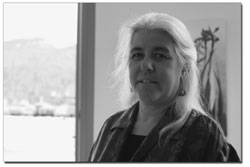|
| ||||
| Painting for preservation
by Jules Masterjohn Many of us know the enjoyment that a favorite painting can bring to our environment. Most of us, however, don’t comprehend how powerfully a colorful canvas can impact our society. Do we believe that mere pigment, artfully arranged, can change the world? Throughout history and over time, art has beneficially affected world cultures, yet can art directly cause positive social change? The Oak Group, a contingent of plein air painters living in the Santa Barbara area of California, is an inspiring example of how a small group of committed individuals can positively impact issues of the day. The Oak Group has become legendary for its efforts in preserving open space and wilderness by painting endangered landscapes. According to The Oak Group’s website, 15 years ago a small group of friends, all painters, gathered on a coastal California bluff to describe, in paint, the beauty of the landscape surrounding them. Soon after their painting expedition, the artists discovered that the eucalyptus and cypress-covered fields were scheduled for development. The group decided to publicize the disappearance of this unique habitat by holding an exhibition of their paintings. Now, with 54 exhibitions to their credit, The Oak Group has more than doubled in size and has been responsible for preserving numerous tracts of land in Santa Barbara and Marin counties. Having generated nearly $1.5 million from painting sales, the group has donated half this amount to groups working in the land-conservation movement, such as The Land Trust for Santa Barbara County, The Marin Agricultural Land Trust and The Nature Conservancy. Through their conscious intention and developed talents, The Oak Group has raised awareness of and appreciation for the uniqueness of what surrounds them by documenting the beauty of the land in their paintings. Local painter and gallery owner Karyn Gabaldon shares this perspective and believes that artists are record keepers of the landscape, and of politics, religion, history and of the dream state. Her belief is most apparent in her watercolors of a Durango ridgeline, “A Moment” and “A Precious View,” both on display at the downtown gallery bearing her name. Intentionally titled, these were created with the clear understanding that her particular view of the western ridgeline could be gone in an instant. Making reference to the presence of buildings appearing on the ridgeline near the cemetery, she offered, “One day we may look up and this beautiful ridgeline may not be there.”
A Durango resident for more than 35 years, as long as she has lived here she has painted the ridgelines. “I chose to live here because I can look up and see the beauty all around. I need that around me, and it hurts to see building on the ridgelines.” As an act of preservation, Gabaldon has turned her paper and paint to the West with a new intention. She feels that it is part of her job as an artist to “keep track of things,” chronicling and preserving for future generations what has been seen. “It is my responsibility as a gatekeeper of the community. People from out of town have come into the gallery and have asked me, ‘How did you let that happen?’ And I ask myself, ‘How DID I let that happen?’” The visitors and Gabaldon are referring to the aforementioned new building on the ridge just above downtown, an addition that now abruptly alters the western skyline. The artist is careful in her criticism, however. “I am not against growth – Skyridge is great. It is an appropriate location for lots of homes. But when I see a ridgeline taken away, my heart breaks in half, and I have to paint it.” Admittedly better at expressing herself with paint than words, visual art is her chosen form of communication as a citizen. When the River Trails Ranch subdivision was in review, Gabaldon painted small watercolors of the proposed site and gave one to each city councilor. She has also painted Perins Peak in her preservation efforts and shared these images with those in decision-making positions. These paintings show the distinctive profile of the peak, one that rises so familiarly on the western horizon. This horizon line is emphasized in Gabaldon’s ridgeline paintings. The choice to compose her paintings using an extreme horizontal format heightens the sense of panorama, presenting a sweeping grandeur that is part of the felt-sense of any ridgeline. For Gabaldon, the earth is sacred. Before becoming a painter of the land, she was a potter, using the earth to shape her creative visions. Even in her pottery, the ridgeline found its place: she carved each rim of her large format vessels as if it were the horizon, the place that Gabaldon identifies as “the line where Heaven meets Earth.” As one turns 360 degrees eyeing the line defined by land and sky, one is reminded that we are placed on the land, nestled in it, dependent upon it. Gabaldon’s paintings ask us to remember our place in nature. • Gabaldon’s paintings can be seen at Karyn Gabaldon Fine Arts, 680 Main Ave. Gallery hours are 10 a.m. -6 p.m., Monday - Thursday; 10 a.m. – 8 p.m. Friday & Saturday; and noon – 6 p.m. Sunday. For information about The Oak Group, visit www.theoakgroup.org.
|



